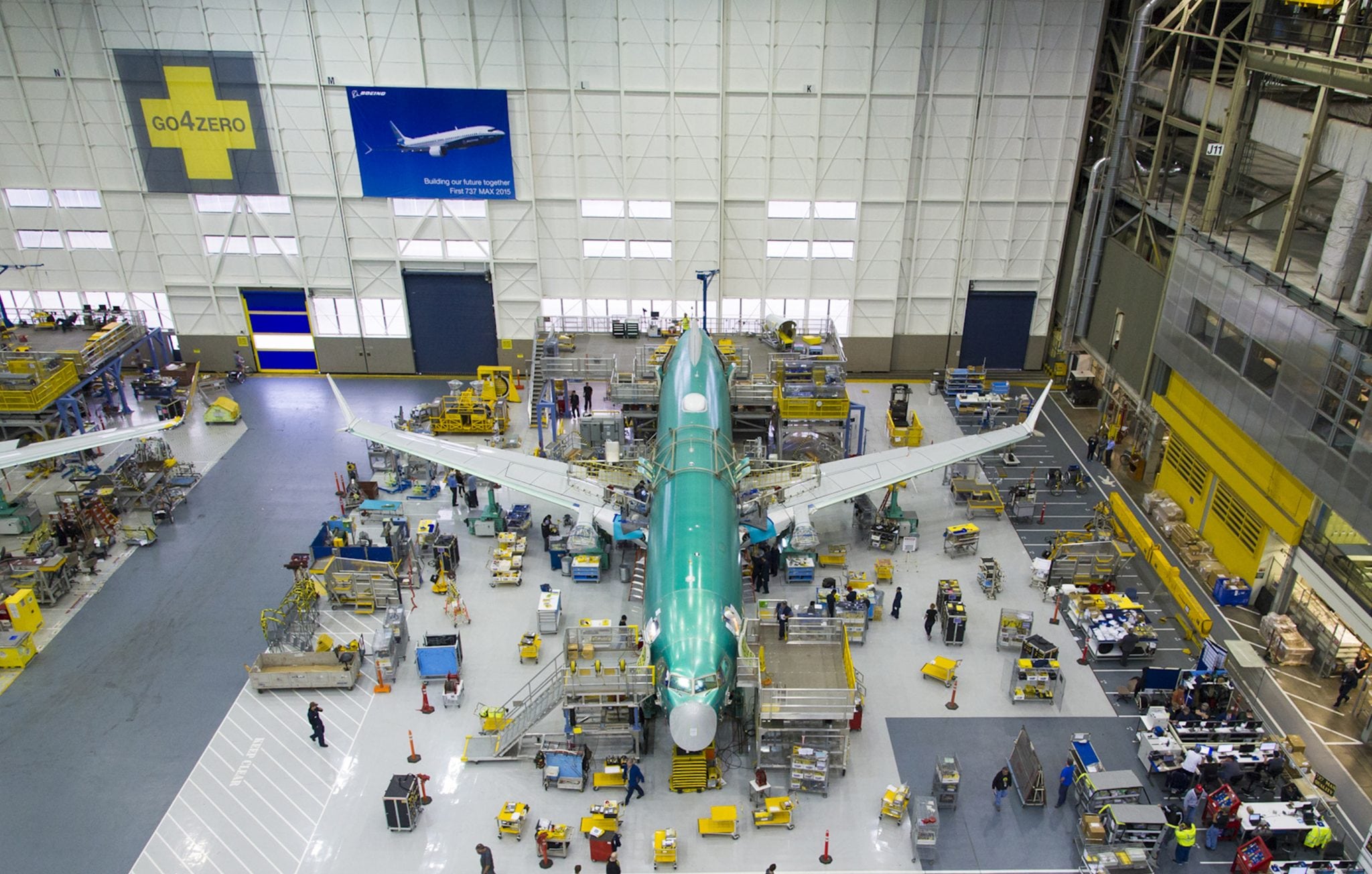
A 737 MAX on the line at the company’s Renton, Washington, factory. Photo courtesy of Boeing
Boeing reported over $25.1 billion in third-quarter earnings Wednesday — up $900 million, or 3.8%, year over year (YOY) — despite stagnant commercial revenues thanks to growth in the smaller defense and services sectors. The company raised its revenue guidance for the year by $1 billion to between $98 and $100 billion.
Commercial
Revenues for the company’s commercial business dropped 0.7% from $15.4 billion in third-quarter 2017 to $15.3 billion at the same time this year. One of the big drivers of that is struggles with the 737 MAX, which has fallen behind on production primarily due to supply chain problems with CFM-produced engines and Spirit-supplied fuselages.
Boeing CEO Dennis Muilenburg said the company has gotten involved in solving those issues, with the fuselage bottleneck mostly worked out and “engine recovery toward the end of the year” anticipated. The current target delivery rate for the 737 MAX is 52; 61 were delivered in September, and Muilenburg said he expects the company to continue delivering above the target rate in the fourth quarter in an effort to get back on track.
Despite the problems with the 737 MAX, Muilenburg and CFO Greg Smith expressed optimism for the commercial business. Boeing anticipates 42,730 new planes needed over the next 20 years. The company closed its joint venture with Adient seating and, notably, is looking ahead to the much-anticipated new mid-market aircraft (NMA), where it plans to take lessons from across the company’s other programs.
“We’re looking at, how does that make us more efficient and more productive on the NMA, and how does it de-risk the NMA business case?” Muilenburg said. “It’s really bringing the best of Boeing together and not reliving lessons. … We’ve had NMA teams, we’ve had 787 teams over on T-X, we’ve had T-X teams over on NMA.”
Smith has previously talked about how a recalibration of risk assessment has guided the company’s plans for partnerships versus internal production on the NMA and contributed to recent acquisitions.
Defense, Space & Security
Boeing’s defense segment had a busy quarter: The company won awards from the U.S. Navy for the MQ-25 UAS and the U.S. Air Force for the T-X Trainer program, to replace the UH-1N Huey with its MH-139 helicopter and to provide a fourth production lot for the troubled KC-46 Pegasus tanker. Beyond those programs, increased volume on F/A-18 and weapons sales helped drive revenue increases of $600 million YOY to $5.7 billion, a 13.5% increase, in a third quarter that also saw the manufacturer acquire Millennium Space Systems to help provide small-sat solutions.
The headliners, the MQ-25 and T-X programs — which Boeing values as potential $20 billion and $40 billion franchises, respectively, in the long term — are fixed-cost deals with the U.S. Defense Department, much like the KC-46. Unlike the Pegasus, though, the Boeing executives are confident that risk-mitigation strategies such as up-front investment will keep costs and timelines in order on the Stingray and the Trainer.
“We have significantly de-risked these programs and they are fundamentally different than tanker. We have two [T-X Trainer] production jets flying today and 71 test flights,” Muilenburg said. “When we started tanker, we still had a design on the drawing board.”
Lockheed Martin Chief Marillyn Hewson, whose company came out on the losing end on all three Boeing wins, said Tuesday her company would have lost $5 billion if it had bid the same prices Boeing had and won. Muilenburg said on the call that the company is looking at the investment and the bids the same way it looks at commercial business.
“This strategy reflects a commercial investment mindset; a deliberate and purposeful decision to position ourselves to capture significant market opportunity in services, support, training and platforms in the autonomous systems, trainer and light attack markets,” he said.
Muilenberg called Boeing’s defense segment “a modest-growth business,” for the company, saying, “It’s healthy, and the recent wins are going to make it more healthy.” He did express a rosy outlook on the state of the industry worldwide.
“It’s a year-to-year battle, but we’re seeing more and more signs of sustained, long-term, stable defense budgets in the U.S.” as well as growth in defense budgets internationally, he said. “Within that, funding for our programs has been very strong.”
Global Services
Boeing’s new Global Services segment saw revenues of $4.1 billion for the quarter, up 14.3% from $3.6 billion for the same period last year. The company closed its acquisition of parts distributor KLX in October took in $4 billion worth of orders, while it holds a backlog valued at $20 billion.
During the quarter, GE Capital Aviation Services ordered 20 737-800 freighter conversations and the company earned contracts with the Defense Logistics Agency for F/A-18 spares, with the Navy and the Australian Air Force for P-8A training and the Air Force for MH-139 services support. Boeing also completed the first heavy maintenance check on a P-8A for the Navy.